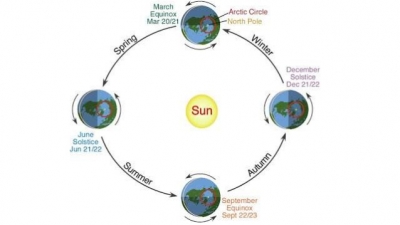
During the year, the seasons change depending on the amount of sunlight reaching the Earth as it revolves around the Sun.
The seasons are caused as the Earth, tilted on its axis, travels in a loop around the Sun each year. Summer happens in the hemisphere tilted towards the Sun, and winter happens in the hemisphere tilted away from the Sun. As the Earth travels around the Sun, the hemisphere that is tilted towards or away from the Sun changes.
The hemisphere that is tilted towards the Sun is warmer because sunlight travels more directly to the Earth’s surface so less gets scattered in the atmosphere. That means that when it is summer in the Northern Hemisphere, it is winter in the Southern Hemisphere. The hemisphere tilted towards the Sun has longer days and shorter nights. That’s why days are longer during the summer than during the winter.
In general, the further away from the equator you travel, the cooler summer and winter temperatures become. At the equator there are no seasons because each day the Sun strikes at about the same angle. Every day of the year the equator receives about 12 hours of sunlight. The poles remain cool because they are never tilted in a direct path of sunlight. Much light is scattered by the atmosphere before reaching the Earth surface at the poles. During midwinter, when a pole is tilted away from the Sun, there is no daylight at all. The sun never rises! However, during the summer, a pole receives sunlight all the time and there is no night!
Picture Credit : Google
